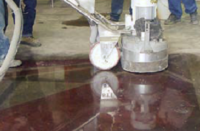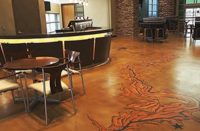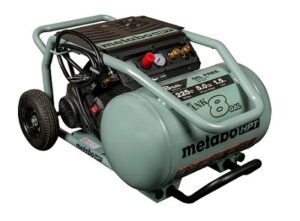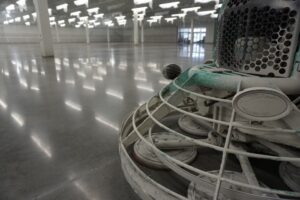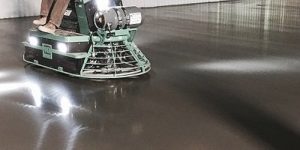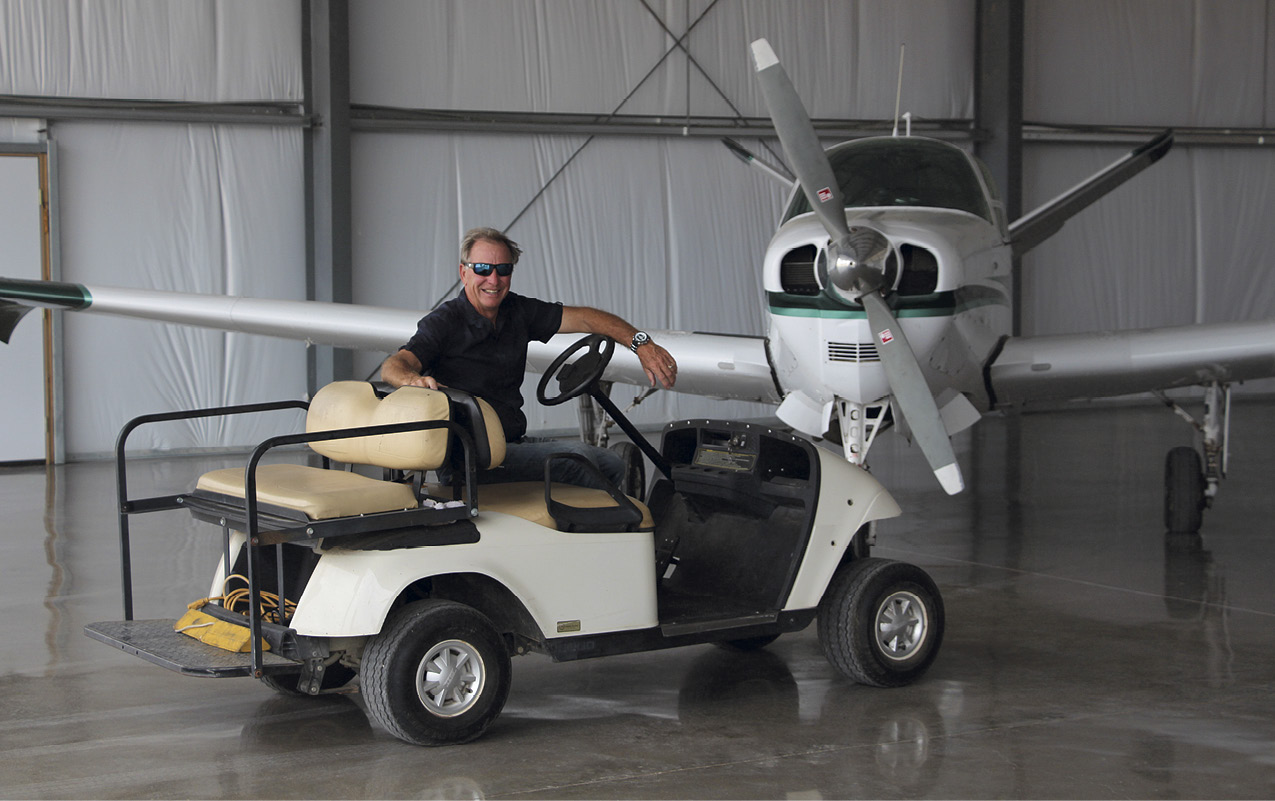
Brad Obbink went all-in as a polished concrete contractor a few years ago, discarding the paint pot and brush and hitching his fortunes to the concrete grinder/polisher, for better or worse.
Now, after a few years and miles of polished concrete behind him, he’s ready to take a ride on one of the biggest — if not the biggest — technical leaps the trade has seen since the early days of its emergence as a major player in design and construction.
That would be continued development and refinement of the power trowel as a concrete grinding and polishing instrument. Obbink has ambitious plans for this pursuit under the banner of his Chicago-based company, ProFinish, operated with co-owner, Ralph Monday.
“This is a game changer,” Obbink says, in particular for big box stores, warehouses and other large spaces. “Those who can capture this market quickly and dominate from the technical side are going to retire young and healthy.”
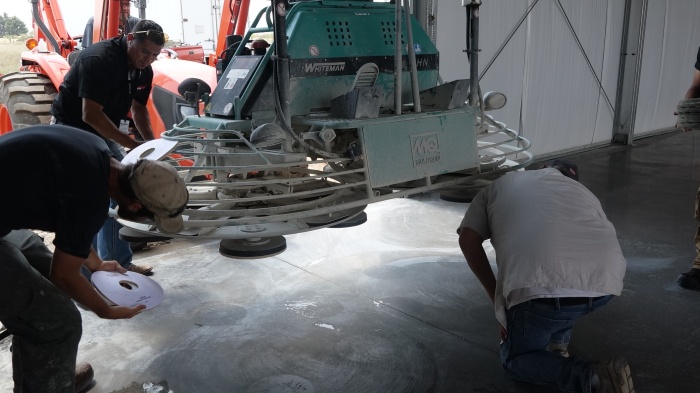
Making the case
The math makes for a convincing case, he reasons: A conventional concrete grinding machine might process somewhere from 4,600 to 8,000 square feet in eight hours. A ride-on power trowel with an eight-foot span could process that much in an hour in an open space.
Obbink points to a recent demonstration project, an airport hangar in Alpine, Texas. Here they completed the whole grinding/densifying/polishing process in about four hours. This included cutting, honing, densifying and polishing. They also filmed the job as a demonstration of the power trowel’s proficiency as a grinding/polishing tool.
It’s no wonder that Obbink is a recent convert to the power trowel polishing methodology.
“This launched us into a much bigger arena,” he says.
In another recent project, Obbink’s company polished a 2,800-square-foot concrete floor in a “man cave” in Austin, Texas.
In both these projects, Obbink’s crews benefited from open spaces and expansive door openings that allowed entry with the sizeable power trowel. That’s one of the keys to power trowel grinding/polishing — getting the machinery in the door.
The equipment, meanwhile, is a Multiquip power trowel modified by Lavina/Superabrasive under the Trowel Shine system banner. The addition of a slurry guard is an innovation from Obbink’s company.
Superabrasive says grinding tool changes are “fast and easy” using 10.63-inch or 14-inch tool holders and diamond pads (depending on power trowel pan size and number of blades). Different diamond-grit pads are available for two categories of concrete — “hard” and “medium and soft.” Other grinding and polishing tools are offered for damaged floors or those that exhibit a “rain-drop” effect, and for additional polishing steps with finer grit sizes, namely 1,800 and 3,500.
Catching the wave early
Obbink, a man of expansive imagination and ambitions, is assembling a licensing program for concrete polishing, largely built around and catalyzed by the power trowel-turned-grinder/polisher. They designed the licensing business model to simplify contractor start-ups or new business add-ons with the tools and expertise to ride the power trowel wave as it’s just starting to gain momentum.
This business model, he says, will identify three different process protocols, based on project size — residential/light commercial (up to 50,000 square feet), commercial/industrial (50,000 to 200,000 square feet) and distribution/warehousing (200,000 to 1 million square feet). The model for each size type will identify equipment needs and other project essentials, and spell out details of practices, processes and other job specifics.
As an example, Obbink cites the issue of slurry management as a critical element when concrete grinding/polishing large spaces with power trowels. Here, it’s essential to include large enough scrubbers and tanks to manage the hefty amounts of slurry. Obbink says his company is refining a slurry separation system that will turn solids into a gel that will go into a landfill, leaving water for reuse or simple emptying.
In another developmental project, the business is exploring a method to reuse material recovered from deteriorated concrete surfaces, mixing it with water and a densifier, and laying it as a new surface for the concrete.
But the key role played by the licensing business, he says, will be to provide answers and solutions to decision-making and problem-solving matters, such as determining which diamond tools to buy considering long-term performance as opposed to simply thinking price and only price.
Other paths to the prize
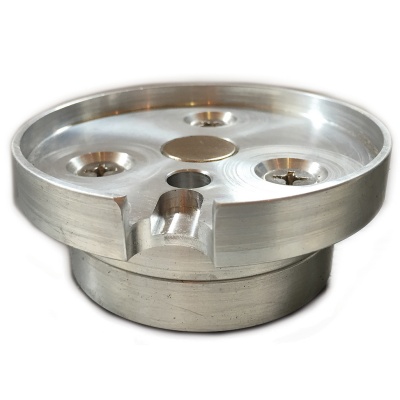
With the power trowel still in the process of finding its footing in the concrete polishing trade, suppliers of equipment and tooling that aid in these adaptations are rolling out new inventions and refinements that aim to smooth out the ride. A few examples follow.
Presto, change-o
Michael Littlefield, the engineer who developed the PowerGrind System for concrete polishing using power trowel equipment, says the PowerFlex Magnetic Quick Release Adapter represents a significant technical innovation in the use of power trowel equipment for concrete polishing.
The adapter is a key component in Polished Concrete Solutions’ PowerGrind System. Littlefield is president of the company, based in Sanford, Maine.
“The flex technology within the adapter allows the operator to maintain precise control of the machine without causing uneven tooling wear, and the quick-change magnetic feature allows metals and resins to attach magnetically, eliminating the hassle of dealing with Velcro,” says Littlefield. “No bolting, no Velcro, no fly-offs, no downtime.”
The power of Velcro
“During the R&D phase, Velcro posed one of the biggest issues in the power trowel polishing process,” he says. “Whether it was pucks hitting lippage and flying off or adhesive delaminating, Velcro was the greatest source of downtime and frustration. By incorporating a completely magnetic system, we’ve eliminated this common source of delay so the operator can keep moving. With a system designed to cover so much ground in such a short period of time, we knew we couldn’t have an unreliable connection system.”
Details in the company’s literature states that the system’s PowerFlex adapters bolt directly to the PowerPan drive plate or any conventional float pan. It goes on to note you can also use the PowerFlex adapter system under any make or model power trowel. Additionally, you can run it effectively on both ride-on and walk-behind power trowels.
The company maintains the PowerFlex system lets users run metal-bond tooling for more aggressive grinding on new or old concrete, in addition to magnetic quick-connect hybrid and resin-bond tooling for finer grinding and polishing.
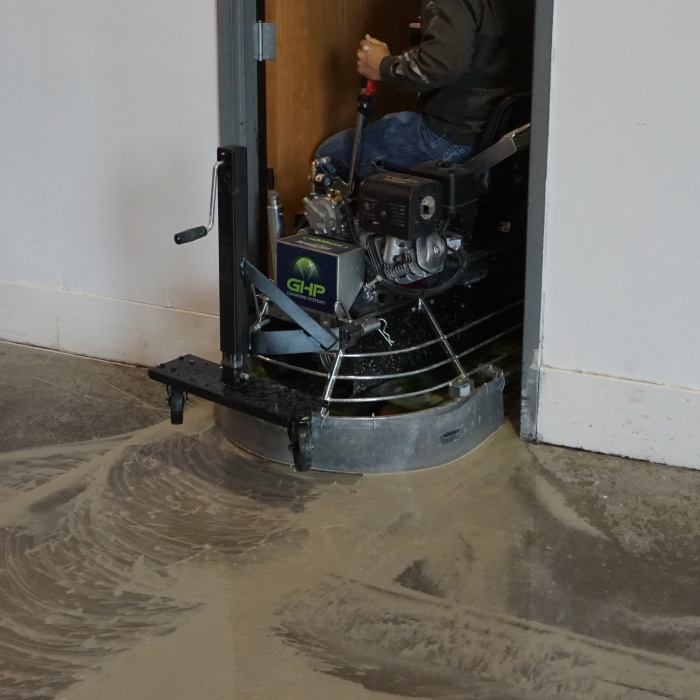
Don’t walk Ride!
“Why walk through slurry when you can ride the GHP LP230?” That’s the proposition put forth by Wagman Metal Products regarding its new ride-on polishing machine.
Wagman, a developer and supplier of power trowel replacement blades, pans and attachments for grinding, polishing and other functions, unveiled the planetary-action Revolution GHP LP230 at the 2017 World of Concrete. Figuring prominently in the company’s pitch for the propane-powered machine is its path of 30-by-63 inches, allowing it to clear a 32-inch doorway and also fit in a pickup truck bed.
The system allows the tooling to “float,” reaching low spots with a desired scratch pattern, says Jeff Snyder, Wagman vice president of sales and marketing. The composite pad offers additional processing and buffing out of swirls, he says.
Key elements of the power trowel-to-grinding/polishing machine include plate-bearing mounts and pad drivers, with mounts and drivers available in various sizes and also for various rotors. Pad drivers are attached to plate-bearing mounts with hardware designed for the system. Then you follow that with the installation on trowel arms.
Other components of the grinding/polishing system are diamond pads designed specifically for wet processing with a power trowel, and optional splash guards, the SPS filtering system for slurry management and abrasion-resistant squeegees designed for polishing.
In addition to grinding and polishing, you can convert the machine into a high-powered scrubbing machine with optional brushes.
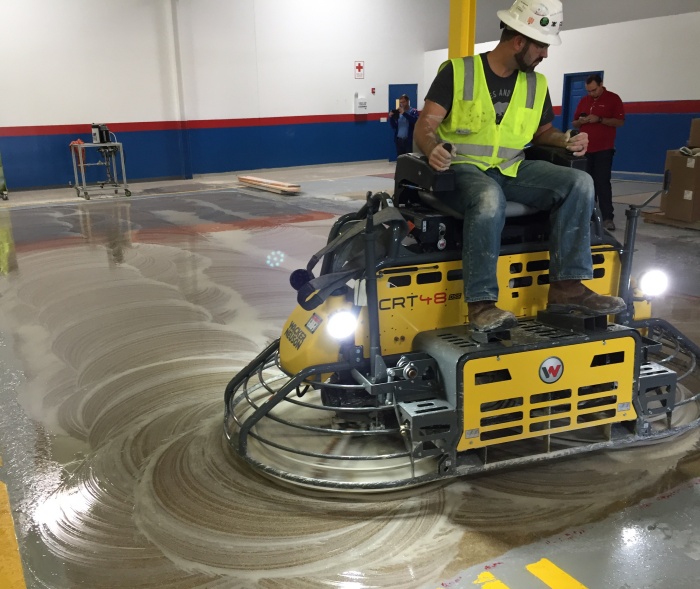
Aiming for ‘standard’ status
Concria, a Finland-based company with a U.S. distribution unit, emphasizes long service life in the equipment it offers for power trowel polishing conversions.
The company also is investing in extensive training programs in response to the rapid uptick in interest and demand in the power trowel polishing business, says Neil Roach, director of operations for Concria’s U.S. distribution company, Architectural Concrete Supplies LLC.
Concria’s power trowel polishing system, called TrowelPolish, offers grind/polish game plans for three different polish levels:
- Basic: a three-step process that produces a matte-satin gloss with salt-and-pepper finish, basically a “low-cost system for warehouses and production facilities.”
- Unique: a four-step process that creates a high-gloss shine with low or no exposed aggregate, where “concrete keeps its unique look after the process.”
- Pro: a six-step process that delivers a high-gloss shine with salt-and-pepper finish, “for the customer who demands the best.”
Roach says you can adapt ride-on power trowels from several different manufacturers for concrete grinding/polishing with the Concria system. The components are a standard floating pan and three elements from Concria — mounting pad, diamond discs and Velcro fastener. The components are available in sizes that fit also different power trowel models.
The polishing system also includes lithium densifier and sealer (guard) products from Concria.
Concria’s marketing focus for the TrowelPolish system reflects a “size does matter” approach in clearly identifying big box retailers, warehouses, convention halls and also production facilities as the types of facilities the company aims to elevate the grinding/polishing system to “standard.”
www.concria.com
www.finishedconcretesystems.com
www.polishedconcretesolutions.com
www.powergrindusa.com
www.superabrasive.us
www.wagmanmetal.com
